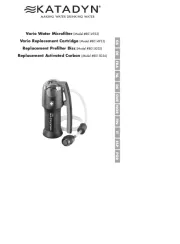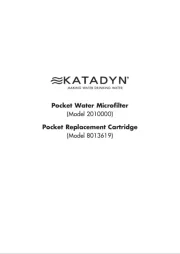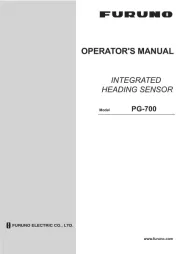Katadyn REPAIR SEAL KIT PowerSurvivor 80E Handleiding
Bekijk gratis de handleiding van Katadyn REPAIR SEAL KIT PowerSurvivor 80E (9 pagina’s), behorend tot de categorie Marine. Deze gids werd als nuttig beoordeeld door 72 mensen en kreeg gemiddeld 4.3 sterren uit 36.5 reviews. Heb je een vraag over Katadyn REPAIR SEAL KIT PowerSurvivor 80E of wil je andere gebruikers van dit product iets vragen? Stel een vraag
Pagina 1/9

INSTALLATION INSTRUCTIONS
REPAIR SEAL KIT
PowerSurvivor 80E
Print No.: 8012825/0 Katadyn North A merica Inc. Katadyn Products Inc.
4830 Azelia Avenue North Pfäffikerstrasse 37
Minneapolis, MN 554429 U.S.A. 8310 Kemptthal Switzerland
Tel +1 800 755 6701 Fax +1 763 746 3540 Tel +41 44 839 21 11 Fax +41 44 830 21 99
marine@katadyn.com www.katadyn.us info@katadyn.ch www.katadyn.ch
PURPOSE OF THE KIT
The Repair Seal Kit should be installed after 1000 hours of operation. It should be installed regardless
of whether or not there is leakage or a reduction of fresh water. Learning to perform this procedure will
ensure optimal performance of your watermaker.
NOTE: If the unit has been operating in water with silt or higher than normal salinity, the Seals will
wear somewhat faster.
Before beginning the Repair Kit procedure, note the following precautions:
1. Keep the work area clean of dirt, hair, and other contaminants.
2. Avoid scratching Pump Components when removing or replacing O-rings.
3. Never use petroleum-based lubricants on Seals and O-rings as a substitute for Silicone
Grease.
4. When installing O-rings do not roll or twist them.
NOTE: Average time to replace all seals is 1 hour. If you are performing this maintenance for the first
time, expect 3 hours.
KIT CONTENTS (See Figs. A-3 and A-4)
TOOLS REQUIRED
Piston Seal Installation Tool – supplied with kit
Needle-nosed pliers
¼-inch Allen wrench
½-inch open-end wrench
11/16-inch open-end wrench
7/8-inch open-end wrench
½-inch deep socket and socket wrench
small flat-blade screwdriver
small scissors

Disassembly:
1. Before beginning disassembly, run the watermaker and stop it when the piston shaft is at its
farthest point of travel away from the pump (toward the drive assembly). This provides enough
room for sliding the rubber boot
back toward the pump in Step 3.
2. Use the 11/16" open-end wrench
to disconnect the two high-
pressure hoses (coming from the
membrane housing) from the tube
connectors on the check valve
plate and the valve assembly.
Loosen the hose clamps and
remove the reinforced plastic
seawater intake and reject brine
hoses. See Figure R-1.
3. Use the 1/2" open-end wrench to
remove the four hex nuts securing
the pump back plate to the drive
assembly. Then pull the pump
away from the drive assembly to expose as much of the piston shaft as possible. Slide the black
rubber boot on the piston shaft toward the pump to expose the shaft coupling pin. Use a small
screwdriver or allen wrench to push the coupling pin out of the shaft. (Note: the coupling pin is a
loose fit and may fall out on its own.
Do not lose it.) Separate the pump
from the drive assembly and set the
drive assembly aside in a safe place.
Slide the black rubber boot off the
piston shaft. Move the pump to a
clean work surface for further
disassembly. See Figure R-2.
4. Remove the plastic intake hose barb
from the check valve plate. While
the pump is still bolted together, use
the 7/8" open-end wrench to just
loosen the tube fitting in the check
valve plate. Then use the 1/4" allen
wrench to remove the six sockethead
flange bolts that hold the check valve
plate to the pump body. Separate
the check valve plate from the pump
body and remove the large o-ring
(8012830) seal between them. See Figure R-2.

5. Disassemble the two check valve assemblies. Use the needlenose pliers to lift the intake valve
retainer, valve spring and poppet valve out of their bore in the inside surface of the check valve
plate. Remove the tube fitting, reject check valve retainer, valve spring and poppet valve from their
bore in the outside surface of the check valve plate. To remove the valve seats, use an allen wrench
(or similar flat-ended tool) to push each valve seat out of its bore, working from the opposite side
of the bore from which the rest of the valve assembly was removed. See Figure R-3.
6. Separate the pump back plate from the pump body by first using the 1/4" allen wrench to re-move
the four sockethead flange bolts that hold them together. It is unlikely that the two parts will
separate easily. Insert the wide end of the piston seal installation tool into the pump body cylinder
from the check valve side of the pump body until it contacts the exposed end of the piston. Use a
soft mallet to tap the small end of the installation tool and drive the piston and pump back plate
away from the pump body. When the back plate has separated from the pump body, pull the
piston out of the back body and remove the two old o-rings (8012830) and (8012444). Be careful
not to lose the large relief valve spring that is exposed when the pump parts separate.
7. Remove the old PIP ring and cup seal from the piston. One method to accomplish this is to wedge
a small screwdriver underneath the
cup seal and pry it up far enough
that it can be cut with a pair of small
scissors or a razor blade. Repeat the
process for the PIP ring.
8. Remove the wiper block from the
pump back plate, and use a pair of
needle-nose pliers to pull the old
wiper block seal out of the wiper
block. Remove the spacer washer, if
present. Working from the side of
the back plate that faces the pump
body, use a flat-ended tool or a
small socket on an extension to press out the two backup washers, two piston shaft seals and shaft
bushing from the back plate. Refer to Figure R-4. This completes the disassembly of all user-
serviceable parts of the Katadyn PowerSurvivor 80E watermaker.
Product specificaties
| Merk: | Katadyn |
| Categorie: | Marine |
| Model: | REPAIR SEAL KIT PowerSurvivor 80E |
Heb je hulp nodig?
Als je hulp nodig hebt met Katadyn REPAIR SEAL KIT PowerSurvivor 80E stel dan hieronder een vraag en andere gebruikers zullen je antwoorden
Handleiding Marine Katadyn

5 Juli 2023

5 Juli 2023

5 Juli 2023

5 Juli 2023

5 Juli 2023

5 Juli 2023
Handleiding Marine
- Geonav
- Nasa
- Alphatron
- Plastimo
- Raymarine
- WEST SYSTEM
- Navman
- Eagle
- Sailtron
- Fastnet
- Kenwood
- KVH
- Echotec
- Icom
- Lowrance
Nieuwste handleidingen voor Marine

26 Februari 2024

16 Oktober 2023

16 Oktober 2023

16 Oktober 2023

12 Oktober 2023

2 Oktober 2023

2 Oktober 2023

2 Oktober 2023

2 Oktober 2023

21 September 2023

